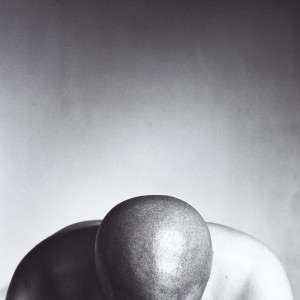Mapplethorpe exhibit comes to LACMA
In a small, dimly lit room on the second floor of the Los Angeles County Museum of Art’s Ahmanson Building, deceptive pieces of art entrance viewers.
Though at first glance the displayed photographs look like Greek classical nudes, they soon reveal themselves to be more akin to images out of a bondage and sado-masochism photoshoot.

Bowed beauty · Known for photos that celebrate the human body, Robert Mapplethorpe captures small details like skin texture in his works. This photo, Cedric, N.Y.C. (X Portfolio), is one of the pieces on display at LACMA. – | Photo courtesy of LACMA
One of LACMA’s newest exhibitions, “Robert Mapplethorpe: XYZ” offers an intimate look into three portfolios by the late American photographer Robert Mapplethorpe. Mapplethorpe’s work, known for its controversial, sexually charged images, met with mixed reviews over the photographer’s lifetime.
The exhibition reflects three subjects Mapplethorpe focused on throughout his career: floral still life, homosexual sadomasochistic acts and nude portraits of African-American men. Though the subject matter of the exhibition might initially shock viewers, a prolonged stay and an open mind reveal a world where the beauty of human sexuality is displayed through Mapplethorpe’s honest portrayal of the human body.
The exhibition opens with three displayed prefaces, each published in one of the portfolios on display, titled X, Y and Z. These prefaces, which include a poem by Paul Schmidt, a prose-like poem by Patti Smith and an essay by Edmund White, immediately establish the intimate nature of the exhibit.
These photographs are not just frank portrayals of subjects’ sexuality — they also offer a look into the mind of Mapplethorpe, whose conceptions of beauty have often been at odds with what are considered appropriate artistic subjects. It is fitting that these three prefaces are displayed in the beginning, for they expand the purpose of the exhibition into one that focuses not just on Mapplethorpe’s imagery, but on Mapplethorpe’s beliefs as well.
The photographs themselves reveal the delicacy of the human body as well as its strength. Mapplethorpe focuses on aspects of the human body, such as the texture of skin and muscle definition, that reveal the body’s paradoxical nature. Mapplethorpe’s subjects are at once vulnerable and powerful, revealing the fragile sensuality of the human body as well as its raw, powerful sexuality.
The nudity within the images contributes to this complexity as well. Many of Mapplethorpe’s subjects are photographed while in the middle of a sexual act. Though many might decry these images as degrading, it becomes clear that being photographed in this manner becomes empowering for the subjects.
Mapplethorpe achieves this through the utilization of light to create a hyper-realistic quality that shows the curved lines of muscle definition and the impeccable smoothness of his subjects’ skin. By paying attention to these details, Mapplethorpe allows the subjects participating in these sexual acts to transgress the initial shock value of what they are doing and to become part of an image that celebrates human sexuality.
Many of Mapplethorpe’s images are also notable for their use of pedestals. By placing his subjects on pedestals, as well as photographing them in black and white, Mapplethorpe likens his subjects to classical Greek nude sculptures. In essence, Mapplethorpe’s photographs celebrate the beauty of the human form and the beauty inherent in sexual acts.
But Mapplethorpe doesn’t photograph his subjects in traditional poses that are commonly associated with portraiture. Instead, subjects are photographed engaged in physical acts, usually with a portion of their body cut off or hidden in shadow. Through this technique, Mapplethorpe isolates certain portions of the human body, rendering a surreal atmosphere within the image. Further, by placing his subjects within abstract backgrounds, Mapplethorpe elevates his subjects into a realm that is appropriate for their unearthly beauty.
Still, Mapplethorpe’s subjects are not gods. They are not specific entities intended to be worshipped by the viewer. Instead they represent the beauty of the human body’s capabilities. The men, photographed with such care, allow a glimpse into the mind of Mapplethorpe, a man who seeks to show the beauty in sexual interactions that have long been considered shameful and immoral.
Understandably, Mapplethorpe’s work has yet to avoid criticism. The frank portrayal of nudity and sexual acts, as well as Mapplethorpe’s focus on African-American men, has given critics grounds for dismissing Mapplethorpe’s work as exploitative.
After looking through Mapplethorpe’s photographs, however, what emerges is not the exploitation of African-American bodies for sensation or profit, but rather, the realization of Mapplethorpe’s belief in the beauty of the human body, especially the African-American body, and a desire to photograph people in a way that grants them power and agency over their image.
Indeed, it is the gaze of Mapplethorpe’s subjects that stay with the viewer long after leaving the exhibition. When Mapplethorpe chooses to photograph a subject that is looking at the camera, the look is never of shame, fear or blatant sexuality. Instead, it is always a combination of pride, of curiosity and of an awareness of the ability of the subject’s body to transgress its physicality into the most abstract conceptions of beauty.
“Robert Mapplethorpe: XYZ” runs until March 24, 2013.

eye for detail that makes the subject more human than that of a more power image of which the body is clothed with color